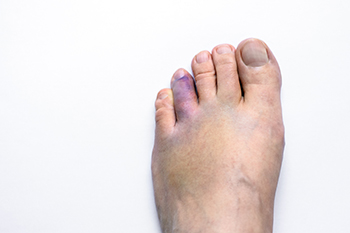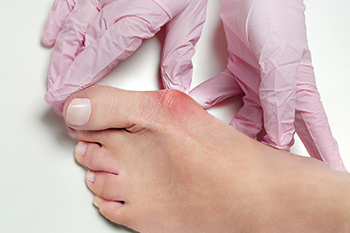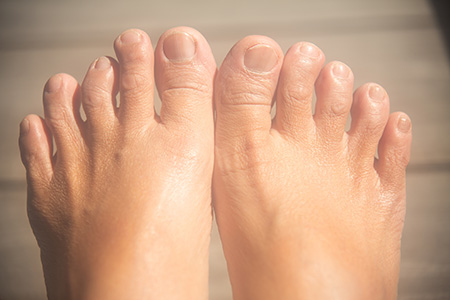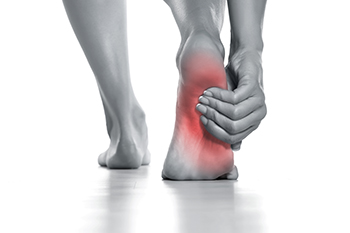January 2025
Causes and Symptoms of a Sprained Toe

A sprained toe occurs when the ligaments in the toe are stretched or torn. This injury often results from trauma, such as stubbing the toe, or from hyperextension, where the joint is forced beyond its normal range of motion. A sprained toe is different from a broken toe, which involves damage to the bone rather than the ligament. Symptoms include pain, swelling, bruising, tenderness, and difficulty moving the toe. Some patients may also experience joint instability or hear a popping sound when the injury occurs. Any of the numerous joints in the toes can be affected, and the severity can range from minor ligament stretching to complete tears. Athletes and others who engage in activities involving sudden movements or uneven surfaces are at a higher risk of spraining a toe. A podiatrist can diagnose the injury by examining the toe, discussing its cause, and using imaging, such as X-rays, to rule out fractures. If you have injured your toe, it is suggested that you make an appointment with a podiatrist for a diagnosis and appropriate treatment.
Toe pain can disrupt your daily activities. If you have any concerns, contact Dr. Steven Schwartz of Pennsylvania. Our doctor can provide the care you need to keep you pain-free and on your feet.
What Causes Toe Pain?
Most severe toe pain is caused due to a sports injury, trauma from dropping something heavy on the toe, or bumping into something rigid. Other problems can develop over time for various reasons.
Toe pain can be caused by one or more ailments. The most common include:
- Trauma
- Sports injury
- Wearing shoes that are too tight
- Arthritis
- Gout
- Corns and calluses
- Hammertoe
- Bunions
- Blisters
- Ingrown toenails
- Sprains
- Fractures (broken bones)
- Dislocations
When to See a Podiatrist
- Severe pain
- Persistent pain that lasts more than a week
- Signs of infection
- Continued swelling
- Pain that prevents walking
Diagnosis
In many cases the cause of toe pain is obvious, but in others, a podiatrist may want to use more advanced methods to determine the problem. These can range from simple visual inspections and sensation tests to X-rays and MRI scans. Prior medical history, family medical history, and any recent physical traumatic events will all be taken into consideration for a proper diagnosis.
Treatment
Treatments for toe pain and injuries vary and may include shoe inserts, padding, taping, medicines, injections, and in some cases, surgery. If you believe that you have broken a toe, please see a podiatrist as soon as possible.
If you have any questions please feel free to contact our offices located in Chambersburg, and Mcconnellsburg, PA . We offer the newest diagnostic tools and technology to treat your foot and ankle needs.
How Bunions Form

A bunion is a bony bump that forms at the base of the big toe, causing the toe to angle toward the second toe. This misalignment leads to pain, swelling, and difficulty in finding comfortable shoes. Bunions are often caused by a combination of factors, including genetics, abnormal foot mechanics, and wearing tight, ill-fitting shoes that put excessive pressure on the toes. Over time, the pressure can force the joint to shift, resulting in the formation of the bony protrusion. The severity of bunions can vary, with mild cases causing minimal discomfort, while severe cases may lead to significant pain and difficulty walking. In more advanced stages, the affected toe may become rigid and inflamed. Relief options range from conservative measures such as wearing supportive shoes and using padding, to surgical intervention in extreme cases where pain and deformity are unmanageable. If you have a bunion, it is suggested that you are under the care of a podiatrist who can monitor its growth, and offer appropriate treatment solutions.
If you are suffering from bunions, contact Dr. Steven Schwartz of Pennsylvania. Our doctor can provide the care you need to keep you pain-free and on your feet.
What Is a Bunion?
A bunion is formed of swollen tissue or an enlargement of boney growth, usually located at the base joint of the toe that connects to the foot. The swelling occurs due to the bones in the big toe shifting inward, which impacts the other toes of the foot. This causes the area around the base of the big toe to become inflamed and painful.
Why Do Bunions Form?
Genetics – Susceptibility to bunions are often hereditary
Stress on the feet – Poorly fitted and uncomfortable footwear that places stress on feet, such as heels, can worsen existing bunions
How Are Bunions Diagnosed?
Doctors often perform two tests – blood tests and x-rays – when trying to diagnose bunions, especially in the early stages of development. Blood tests help determine if the foot pain is being caused by something else, such as arthritis, while x-rays provide a clear picture of your bone structure to your doctor.
How Are Bunions Treated?
- Refrain from wearing heels or similar shoes that cause discomfort
- Select wider shoes that can provide more comfort and reduce pain
- Anti-inflammatory and pain management drugs
- Orthotics or foot inserts
- Surgery
If you have any questions, please feel free to contact our offices located in Chambersburg, and Mcconnellsburg, PA . We offer the newest diagnostic and treatment technologies for all your foot care needs.
Understanding Congenital Foot Conditions

Congenital foot conditions are present at birth and can affect the alignment and structure of the feet. Such foot problems are common, where the bones and soft tissues do not develop properly, leading to abnormal foot shapes. One such condition is flatfoot, where the arches do not develop, resulting in a foot that appears flat when standing. Another condition is hallux valgus, commonly known as a bunion, where the big toe points inward, causing a bony bump at the joint. Splay foot occurs when the arch flattens, causing the toes to spread out and increase the width of the foot. Hollow foot, or cavus foot, is characterized by an excessively high arch, leading to pain and difficulty in walking. These conditions may vary in severity, and early diagnosis can help prevent long-term issues. If you have any of the above foot conditions, it is suggested that you consult a podiatrist who can offer effective treatments.
Congenital foot problems require immediate attention to avoid future complications. If you have any concerns, contact Dr. Steven Schwartz of Pennsylvania. Our doctor can provide the care you need to keep you pain-free and on your feet.
Congenital foot problems are deformities affecting the feet, toes, and/or ankles that children are born with. Some of these conditions have a genetic cause while others just happen. Some specific foot ailments that children may be born with include clubfeet, polydactyly/macrodactyly, and cleft foot. There are several other foot anomalies that can occur congenitally. What all of these conditions have in common is that a child may experience difficulty walking or performing everyday activities, as well as trouble finding footwear that fits their foot deformity. Some of these conditions are more serious than others. Consulting with a podiatrist as early as possible will help in properly diagnosing a child’s foot condition while getting the necessary treatment underway.
What are Causes of Congenital Foot Problem?
A congenital foot problem is one that happens to a child at birth. These conditions can be caused by a genetic predisposition, developmental or positional abnormalities during gestation, or with no known cause.
What are Symptoms of Congenital Foot Problems?
Symptoms vary by the congenital condition. Symptoms may consist of the following:
- Clubfoot, where tendons are shortened, bones are shaped differently, and the Achilles tendon is tight, causing the foot to point in and down. It is also possible for the soles of the feet to face each other.
- Polydactyly, which usually consists of a nubbin or small lump of tissue without a bone, a toe that is partially formed but has no joints, or an extra toe.
- Vertical talus, where the talus bone forms in the wrong position causing other bones in the foot to line up improperly, the front of the foot to point up, and the bottom of the foot to stiffen, with no arch, and to curve out.
- Tarsal coalition, when there is an abnormal connection of two or more bones in the foot leading to severe, rigid flatfoot.
- Cleft foot, where there are missing toes, a V-shaped cleft, and other anatomical differences.
- Macrodactyly, when the toes are abnormally large due to overgrowth of the underlying bone or soft tissue.
Treatment and Prevention
While there is nothing one can do to prevent congenital foot problems, raising awareness and receiving neonatal screenings are important. Early detection by taking your child to a podiatrist leads to the best outcome possible.
If you have any questions please feel free to contact our offices located in Chambersburg, and Mcconnellsburg, PA . We offer the newest diagnostic tools and technology to treat your foot and ankle needs.
Tibialis Posterior Rupture

A tibialis posterior rupture is a significant injury involving the tendon that supports the arch of the foot and aids in stability during walking. This tendon is essential for proper foot movement and alignment. Ruptures are often caused by overuse, trauma, or degenerative changes, particularly in individuals with flat feet or those involved in repetitive, high-impact activities. Symptoms include pain along the inner ankle or foot, swelling, difficulty walking, and progressive flattening of the arch. Left untreated, the condition can lead to severe flatfoot deformity and impaired mobility. Diagnosis typically involves a clinical exam, imaging like an MRI scan, and functional assessments. Treatment options range from rest, bracing, and targeted exercises, to surgical repair for severe cases. Early intervention is essential for optimal recovery. If you suspect such a rupture, it is suggested that you consult a podiatrist for evaluation and a tailored treatment plan.
Ankle pain can have many different causes and the pain may potentially be serious. If you have ankle pain, consult with Dr. Steven Schwartz from Pennsylvania. Our doctor will assess your condition and provide you with quality foot and ankle treatment.
Ankle pain is any condition that causes pain in the ankle. Due to the fact that the ankle consists of tendons, muscles, bones, and ligaments, ankle pain can come from a number of different conditions.
Causes
The most common causes of ankle pain include:
- Types of arthritis (rheumatoid, osteoarthritis, and gout)
- Ankle sprains
- Broken ankles
- Achilles tendinitis
- Achilles tendon rupture
- Stress fractures
- Tarsal tunnel syndrome
- Plantar fasciitis
Symptoms
Symptoms of ankle injury vary based upon the condition. Pain may include general pain and discomfort, swelling, aching, redness, bruising, burning or stabbing sensations, and/or loss of sensation.
Diagnosis
Due to the wide variety of potential causes of ankle pain, podiatrists will utilize a number of different methods to properly diagnose ankle pain. This can include asking for personal and family medical histories and of any recent injuries. Further diagnosis may include sensation tests, a physical examination, and potentially x-rays or other imaging tests.
Treatment
Just as the range of causes varies widely, so do treatments. Some more common treatments are rest, ice packs, keeping pressure off the foot, orthotics and braces, medication for inflammation and pain, and surgery.
If you have any questions, please feel free to contact our offices located in Chambersburg, and Mcconnellsburg, PA . We offer the newest diagnostic and treatment technologies for all your foot care needs.


